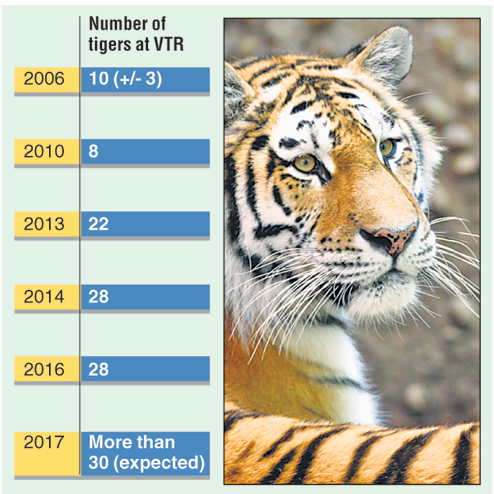Forest department officials are confident that Valmiki Tiger Reserve, Bihar's lone sanctuary for India's national animal, is now home to more than 30 big cats.
They arrived at the figure after scanning pictures from camera traps set up in the reserve for conducting the annual internal tiger census. Last year, the number of tigers was pegged at 28.
"Going by the pictures captured in the camera traps, we are confident that the tiger number would cross the 30 mark when the official announcement would be made," a senior forest department official told The Telegraph. "This increased number has been witnessed even though we have not taken into the account a tigress that has strayed into the adjoining Sohagi Barwa reserve in Uttar Pradesh."
Valmiki shares boundaries with the reserve in UP and areas next to the Chitwan National Park of Nepal.
The camera trap data have been sent to the Wildlife Institute of India in Dehradun, which would process it and submit an official report on the internal census of tigers at Valmiki. "We sent the cameral trap data to the WII in March this year and expect to get the report from there within a month," said the official. The internal census at Valmiki was conducted from December 2016 to February this year and 250 pairs of camera traps were used.
Camera traps were placed in different ranges of the reserve, which is spread over an area of 898 square km.
Earlier, the tiger census used to be conducted every four years. In 2010, two years after tiger numbers in India fell to an alarming low of around 1,400, the national tiger conservation authority came up with fresh guidelines instructing tiger reserves to conduct the census annually as well. The purpose was to keep a tab on tiger numbers in the years between the quadrennial exercise so that corrective steps can be immediately taken in case of any alarming decrease in tiger numbers in any reserve of the country.

As it took time for the states to make the necessary preparations for conducting the internal census, many tiger reserves could not start the work in 2011. At Valmiki, the first internal census was conducted in 2012 in collaboration with the World Wildlife Fund and its result - 22 tigers - was known in 2013.
Asked for comment on the tiger numbers at Valmiki, wildlife conservationist and state coordinator of Wildlife Trust of India, Samir Kumar Sinha said: "Ideally, one should comment on such issues only after figures are released officially but if at all there is any substance in the claims of the officials, I would say that better habitat management would have played a major role for any increase in tiger numbers."
Samir, who has been conducting wildlife-related research at the reserve since 2003, said grassland management has improved which, in turn, could positively contribute to the growth of herbivores - the prey base for tigers - in the reserve. A senior field official at Valmiki echoed Sinha's views and claimed that the average herbivore population at the reserve had increased to around 20 per square km from 14-15 five years back.
"We have worked very hard for habitat improvement at the reserve and increase in tiger numbers is the outcome of these efforts," the official said.










